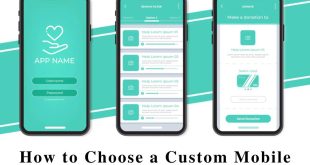Android App Development
When it comes to Android app development, there are many things to consider. These include the various tools such as Gradle, Java, Kotlin, and Android SDK. In addition, an application is constantly evolving and must be supported and improved. Typically, an Android development team will work on all three parts at once: the development, testing, and support.
Gradle
When developing Android applications, it’s beneficial to use a CI tool like Gradle. Gradle uses a source set for your project, which is a collection of source files that are compiled and executed together. For example, if you’re developing an Android app, the main source set will contain all of the resources for your app. Similarly, if you’re developing tests for your app, you’ll want to put your tests into a separate source set called androidTest.
When using Gradle, you can create modules to divide your project into discrete functional units. A module can be one or many, and each module can have its own dependencies. Each module has a separate Gradle build file. When creating a module, you can define the dependencies for the module, so that Gradle will know which files to include in the app.
Android Studio comes with a Gradle build system. When you create a project with Android studio, the run button in the Android studio window will trigger the Gradle build process. You can also run Gradle from the command line. Gradle comes with a wrapper script that you can use to configure your build system.
Another way to use Gradle is by creating a custom build variant for your project. You can do this by implementing an Android Gradle plugin that applies a Plugin class to the project. Plugins can be very useful for creating custom APK files and build variants. You can even write a custom Gradle task to change the output file name of an APK file.
Gradle is a powerful build system that can make your app development projects easier and faster. With its comprehensive API and built-in features, you can easily develop and deploy applications using it. The best part about Gradle is that you can use it with any programming language and platform. In fact, you can run it from the command line, using Android Studio, or through a continuous integration server. Regardless of which version you choose, your builds will always be consistent and elegant.
Kotlin
This book will teach you how to use Kotlin for Android app development. It includes a large collection of code listings and guides you through the creation of two Android apps. Kotlin is a language that is becoming increasingly popular among developers. It’s a fast and easy way to create robust applications.
Kotlin is also lightweight and thin, which is great for smaller programs and memory-constrained platforms. Compared to Java, Kotlin’s code is far shorter, which helps reduce boilerplate code and make development quicker. This reduces errors and developer fatigue, while still maintaining code readability and scalability.
As with any new programming language, there is a learning curve associated with Kotlin. It is important to allow yourself enough time to become familiar with the language before you start developing your first project in it. The switch will introduce some unexpected challenges and pitfalls that you’ll need to overcome. You’ll also have to recognize the impact of the switch on your existing architecture. If your existing architecture isn’t built for Kotlin, you’ll have to rewrite your code and optimize it.
Another benefit of using Kotlin is that it helps you get rid of NullPointerExceptions. Those errors can cause a program to crash and can slow down the development of your app. Fortunately, Kotlin allows developers to catch these problems during compile time.
If you’re not familiar with Kotlin, there are plenty of resources online that can help you learn how to use it. There are forums, sample projects, and more to help you get started. By learning Kotlin, you’ll be able to write a much better application than you could in Java.
Java
Java is a versatile programming language that offers the features that an application needs. This makes it an obvious choice for Android app development. Java developers can take advantage of these properties and develop mobile applications that are scalable and easy to maintain. Java developers can easily create a new mobile application and customize the existing one to suit their needs.
Another benefit of using Java for Android app development is its expansive community. Many other Android developers will share their insights and data with newcomers, and this helps them to hone their Java app development skills. This network of developers can even help beginners with problems and hold discussions. You can use this to your advantage and build a network of Android app developers who can share their experience and insights.
Android app development is a complicated process. Beginners should focus on a project that is manageable and achievable, and then build from there. As you gain experience, you will be tempted to add features and try new things. Having a specific goal keeps the learning process organized and fun. Just keep in mind that it will take some time to learn everything that is required for a project. The more projects you can take on, the more confident you will become.
Android app developers need to have the knowledge of Android SDK. This toolkit contains various libraries and IDEs, and allows you to use the full capabilities of Android OS. In addition, it includes code samples, documentation, and emulators.
Android SDK
Android SDK for app development allows developers to write Android apps in the Java, Kotlin, or C++ programming languages. It also allows developers to use other programming languages. Using the Android SDK for app development is the fastest way to develop apps for Android devices. This article outlines the steps involved in developing apps for Android.
The Android SDK includes tools for creating and testing apps for Android devices. The tools include an emulator and a virtual device manager. Both are useful for coding and testing apps. The emulator comes with configurations that mimic the various Android devices. This emulator makes it much faster and easier to test apps for Android platforms. The emulator also includes extensive documentation, tutorials, and a wide array of tools to help developers build Android apps.
The Android SDK is an essential part of the Android app development industry. It provides all the tools needed to develop Android apps, including the ADB bridge, emulators, and other tools. It allows developers to create Android apps and access the special features of the OS. It also makes it easy to test apps on different devices and monitor their performance. While the SDK is included with the Android Studio app development environment, it can also be downloaded separately.
To develop Android apps, developers must have access to the Android SDK and Java Development Kit. They must be familiar with the various tools and how they work. If you’re a beginner, you can use the Android SDK to write programs in the command prompt, but the most common way to write apps for Android is through an Integrated Development Environment (IDE). The Eclipse IDE is recommended, but there are other options. Most IDEs come with a graphical user interface. Because Android applications are written in Java, you must have Java Development Kit installed on your system.
Android plugin
Android plugins are great for speeding up the development process of Android apps. They allow you to perform many essential actions with just a few clicks. This helps you save time and avoid repetitive tasks. This plugin works with the Android Studio IDE, and it is available in the Android Studio’s plugins menu.
When installing an Android plugin, you must first install the source code for the plugin. The source code will contain details about the plugin. You should also know the version of the plugin you need to install. This will help you to use it more effectively. It is recommended to use the Community Edition of IntelliJ IDEA.
The Android Drawable Preview plugin enables you to see the default icon’s withdrawable preview while analyzing a project. It also provides you with various other features to speed up your Android app development. Despite these benefits, make sure you do not over-add plugins to your development. As you may know, too many plugins can cause the performance to deteriorate.
An Android plugin works in tandem with Gradle. It can be included in your build script or standalone project. You can also use a plugin as a way to automate tasks. A plugin’s build script can be included in the buildSrc directory of your project. An Android plugin can also be used in your IntelliJ project.
Plugins can also improve your productivity and programming experience. By using an Android plugin for Android app development, you can speed up your development process and save time.
 Atech Guides Android APPS
Atech Guides Android APPS







